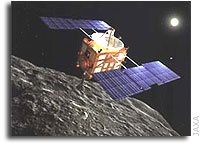Planetary Society Applauds Japanese Asteroid Landing and Apparent Sampling

The Society Celebrates Names of Members Etched on Target Marker That Guided Landing
The Planetary Society sent congratulations to the Hayabusa spacecraft team at the Japanese Space Agency (JAXA) for their remarkable exploration of the asteroid Itokawa, which included a successful rendezvous and landing as well as the apparent collection of a sample from the asteroid’s surface.
Now the Hayabusa mission team is working hard to solve a problem with the spacecraft’s thrusters, which must be fixed to return Hayabusa, and its hoped for asteroid sample, to Earth in 2007.
The sampling site was marked by a softball-sized target, which not only guided Hayabusa to the surface, but also landed the names of 880,000 residents of earth on a very distant chunk of real estate. The Planetary Society helped its sister organization, The Planetary Society of Japan (TPS/J), collect the names in a worldwide campaign in 2002, and the list includes the names of all members of The Planetary Society as of July of that year.
The touchdown of Hayabusa, which means “falcon,” on asteroid Itokawa on Saturday, November 26 has moved Japan into the space exploration spotlight.
“Automated surface sample return has been done only once before in space — by the Soviet Union from the Moon, 33 years ago,” said Louis Friedman, Executive Director of The Planetary Society. “The rendezvous at asteroid Itokawa and the attempts to land on, explore and ultimately sample it have been a grand adventure, brilliantly conducted by JAXA, the Japanese Space Agency. It deserves worldwide attention and congratulations from all interested in space.”
During its first attempt to collect a sample on November 20, Hayabusa actually touched down twice and then landed for 30 minutes, but the collection procedure never initiated and the mission team had to command its falcon to fly up and away from the asteroid.
Hayabusa launched on May 9, 2003 and arrived at Itokawa on September 12, 2005. Prior to the sampling attempt, Hayabusa released a small “hopper” that was to explore the asteroid’s surface. The hopper, named Minerva, apparently was lost after deployment when the spacecraft moved away from the asteroid too rapidly. Not much larger than a container ship, Itokawa’s gravity was insufficient to pull Minerva back to its surface.
Hayabusa has been in the vicinity of Itokawa for almost two months taking remarkable images and conducting the landing and sampling mission. See an image of the target marker and the spacecraft’s shadow on the asteroid at http://www.planetary.org/blog/article/00000288/.
For further information on this innovative mission, visit The Planetary Society’s special web section on Hayabusa at http://www.planetary.org/explore/topics/hayabusa/
The website also features several news reports by A. J. S. Rayl as well as Emily Lakdawalla’s daily blog, which captures the immediacy of a mission in progress with excerpts such as this entry from November 21:
“Just imagine what it would have been like to be an observer on Itokawa, seeing this winged spacecraft hovering just 10 meters above your head, blocking the Sun, creeping ever so slowly sideways at the crawling speed of a worm, before swooping upwards again… ” Read more at http://planetary.org/blog.
TPS/J is the first international affiliate of The Planetary Society. Since its inception in 1999, the Japanese organization has sponsored a variety of public outreach activities through its website and publications, both independently and in cooperation with The Planetary Society.
-o0o-
CONTACT INFORMATION:
For more information, contact Susan Lendroth at phone: (626) 793-5100 ext. 237, e-mail: susan.lendroth@planetary.org.
THE PLANETARY SOCIETY:
The Planetary Society has inspired millions of people to explore other worlds and seek other life. Today, its international membership makes the non-governmental Planetary Society the largest space interest group in the world. Carl Sagan, Bruce Murray and Louis Friedman founded The Planetary Society in 1980.
WEBLINKS:
The Planetary Society http://planetary.org








